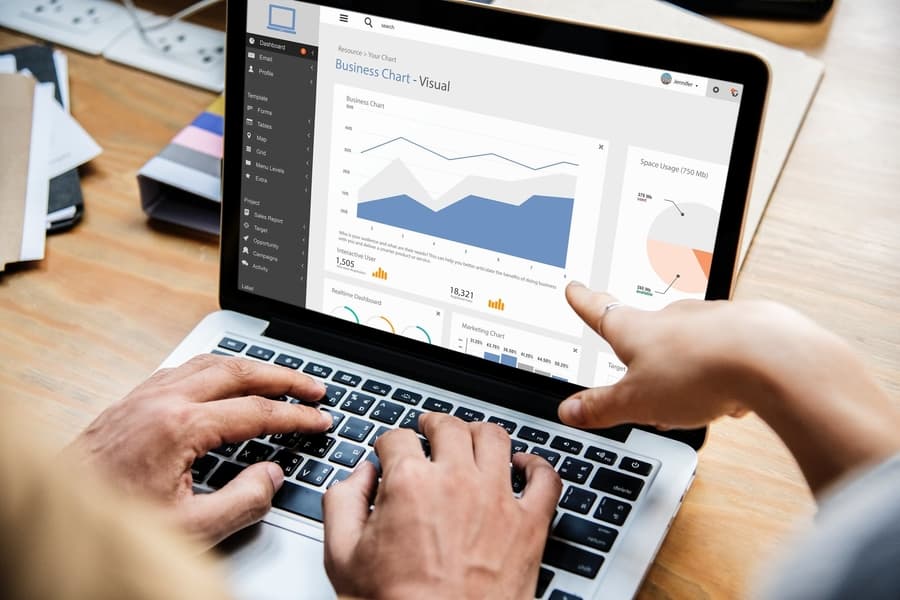Competitor analysis will always be one of the most important steps for any business strategy. In fact, the importance of this form of assessment will only increase with time as every major industry will inevitably become more saturated with competition. Logically, in order to adequately compete, you must know as much as you can about your competitors. However, simply glancing at their website isn't going to tell you much apart from what they're doing design-wise.
Do you want to beat and reverse engineer your fiercest competitor's marketing strategy? To really know what you're up against, you'll need solid data about their web presence, including the type of content they're publishing, their pricing, which websites they're promoting their brand on, what kind of rankings they have in the search engines, as well as which keywords they're targeting, and other crucial info that will help you formulate a better business strategy to compete from an informed and guided perspective.
Of course, collecting all of this info manually would be extremely tedious and time-consuming, and in some cases, it would be downright impractical considering many sites have thousands of pages, links, and search results to catalog. Your first option would be to go to some data brokers that gather and provide data to customers, but their services are so overpriced that saying ‘data’s worth its weight in gold’ sounds like a discount. The only solution with a minimum budget is to utilize software or a script that can automatically gather and organize data for you in a manner that is easy to interpret. Such tools are often referred to as “data scraping scripts, “web scrapers,” or just “data scrapers.”
You can now take advantage of your competitors' authority thanks to brand bidding. There are many to choose from, but they're all designed for the purpose of helping you collect massive amounts of data from specified web sites and search engines. These scrapers won't perform the analysis for you, but they will provide a solid database which you can then further sort and interpret. Since most data scrapers will give you spreadsheet-friendly results, you’ll be well on your way to analysing your competitors.
Even if you eventually hire a consultant or analyst to interpret the data for you, those scraping scripts will always take care of the collection side of the process. With that said, here are the four steps you can take to gain access to and analyse your competitors' online data in a cost-effective manner:
Do you want to beat and reverse engineer your fiercest competitor's marketing strategy? To really know what you're up against, you'll need solid data about their web presence, including the type of content they're publishing, their pricing, which websites they're promoting their brand on, what kind of rankings they have in the search engines, as well as which keywords they're targeting, and other crucial info that will help you formulate a better business strategy to compete from an informed and guided perspective.
Of course, collecting all of this info manually would be extremely tedious and time-consuming, and in some cases, it would be downright impractical considering many sites have thousands of pages, links, and search results to catalog. Your first option would be to go to some data brokers that gather and provide data to customers, but their services are so overpriced that saying ‘data’s worth its weight in gold’ sounds like a discount. The only solution with a minimum budget is to utilize software or a script that can automatically gather and organize data for you in a manner that is easy to interpret. Such tools are often referred to as “data scraping scripts, “web scrapers,” or just “data scrapers.”
You can now take advantage of your competitors' authority thanks to brand bidding. There are many to choose from, but they're all designed for the purpose of helping you collect massive amounts of data from specified web sites and search engines. These scrapers won't perform the analysis for you, but they will provide a solid database which you can then further sort and interpret. Since most data scrapers will give you spreadsheet-friendly results, you’ll be well on your way to analysing your competitors.
Even if you eventually hire a consultant or analyst to interpret the data for you, those scraping scripts will always take care of the collection side of the process. With that said, here are the four steps you can take to gain access to and analyse your competitors' online data in a cost-effective manner:
Step 1: Getting the Tools for Data Scraping
There are many tools available to do a competitive analysis. The most customizable way to do data scraping is to either make an automation script yourself or pay a freelancer/programmer to make one for you. Believe it or not, these scripts are relatively easy to compile for anyone with basic knowledge of programming, so you should be able to find plenty of novice to intermediate freelancers who will offer you a great deal on a custom-made scraping script.
Alternatively, you could use a free scraper such as Scrapy for Python. While the free tools will generally have a slightly steeper learning curve and less appealing aesthetics, they're capable of doing all the essential functions that a paid scraper would perform.
Another option is to use a macro creator to create your own scraping scripts by recording your actions on the web and then using parameters to duplicate what you've done. This wouldn't necessarily require you to learn to program, as there are a number of user-friendly tools that make it easy for anyone to create macros.
If you're willing to put in the research and practice, you could get good enough to make your own bespoke scraping scripts as needed. As a bonus benefit, you could even turn this new ability into an extra source of revenue by offering script creation services on a freelance basis.
Alternatively, you could use a free scraper such as Scrapy for Python. While the free tools will generally have a slightly steeper learning curve and less appealing aesthetics, they're capable of doing all the essential functions that a paid scraper would perform.
Another option is to use a macro creator to create your own scraping scripts by recording your actions on the web and then using parameters to duplicate what you've done. This wouldn't necessarily require you to learn to program, as there are a number of user-friendly tools that make it easy for anyone to create macros.
If you're willing to put in the research and practice, you could get good enough to make your own bespoke scraping scripts as needed. As a bonus benefit, you could even turn this new ability into an extra source of revenue by offering script creation services on a freelance basis.

Step 2: Understanding the Requirements for Data Scraping and Analysis
Before you start using your scraping script or rush out to pay a programmer to make one for you, it's important to understand what you'll need to make the process work properly. Likewise, you should know what features you require within the script that you're going to use, to make sure it is capable of providing the kind of results you're going for.
First, since most scripts will return data in .CSV file format, you'll need to have a basic program that can open this file format such as Microsoft Office or Open Office. Most business owners already have this covered, so this is more of a formal suggestion to those of you who might not yet be familiar with .CSV files and spreadsheets.
If you intend to parse your competitor's HTML data, you might want to use the Beautiful Soup library within the Scrapy framework to get the job done. Ideally, if you're having a scraping tool made, it should come with the ability to specify various data points to retrieve.
For example, you should be able to instruct the tool to scrape your competitor's web site and/or overall web presence for product prices, page titles, images, contacts, link data, etc. It's a good idea to make a list of features that you want for the script before comparing available options. That way, you won't be wasting your own time and possibly the time of your programmer by having to request revisions to the script in hindsight.
The use of proxies is another important requirement to know about. A proxy is essentially a string of identifying numbers (IP address) that your script or browser will use to connect to a specific web server before connecting to the targeted websites. Proxy usage facilitates anonymity because any websites or services that you scrape data from will only see the IP address of the proxy server, not your actual machine, which prevents the script from being blocked. Obtaining proxies will, therefore, is a crucial step for any business who wants to use scraping tools on an ongoing basis without problems. We'll discuss this aspect of script usage more in the next step.
First, since most scripts will return data in .CSV file format, you'll need to have a basic program that can open this file format such as Microsoft Office or Open Office. Most business owners already have this covered, so this is more of a formal suggestion to those of you who might not yet be familiar with .CSV files and spreadsheets.
If you intend to parse your competitor's HTML data, you might want to use the Beautiful Soup library within the Scrapy framework to get the job done. Ideally, if you're having a scraping tool made, it should come with the ability to specify various data points to retrieve.
For example, you should be able to instruct the tool to scrape your competitor's web site and/or overall web presence for product prices, page titles, images, contacts, link data, etc. It's a good idea to make a list of features that you want for the script before comparing available options. That way, you won't be wasting your own time and possibly the time of your programmer by having to request revisions to the script in hindsight.
The use of proxies is another important requirement to know about. A proxy is essentially a string of identifying numbers (IP address) that your script or browser will use to connect to a specific web server before connecting to the targeted websites. Proxy usage facilitates anonymity because any websites or services that you scrape data from will only see the IP address of the proxy server, not your actual machine, which prevents the script from being blocked. Obtaining proxies will, therefore, is a crucial step for any business who wants to use scraping tools on an ongoing basis without problems. We'll discuss this aspect of script usage more in the next step.
Step 3: Running the Scraping Script or Tool Properly
Once you have a scraping script or tool in hand, it's time to put it to good use. You might think this would be as simple as pressing go, but there are certain precautions and measures you'll want to take to ensure you're getting accurate scraping results and avoiding potential mishaps.
First, it's important to ensure that you're using the delay function within the script or tool appropriately. The delay function tells the script how long to wait before performing the next action. This is important because triggering repeated requests from a site during scraping will inevitably lead to the script being blocked from the server, which halts the process altogether until you switch proxies and start again.
Most programmers will know that they will need to include a delay function within the script itself, and they should be able to easily instruct you on which line to edit in order to adjust the delay time as needed. If you notice that the script is committing errors or crashing, in most cases the problem can be solved by using a longer delay time simply because it tells the script to wait until the server has returned the request to continue taking action – you don't want the script to get ahead of itself.
Examples in which a longer delay time would be needed include running scripts on a network with a slow or inconsistent internet connection or performing resource-intensive scraping over an extended period of time. You'll need to do some testing to find the ideal delay time that provides the right balance of reliability and speed for your particular scraping task and network conditions.
As mentioned earlier, the way you use proxies is essential for keeping your scraping script or tool from getting blocked by sites and servers that it is scraping data from. It's usually best to have an extensive list of proxies on standby or a rotating proxy network within the script. The option to switch proxies on a timed basis is a basic feature in most scraping scripts. Alternatively, you could also point the script to the IP address of a rotating proxy network, which automatically takes care of routing the script traffic through varying IP addresses without requiring you to switch the proxy within the script itself.
First, it's important to ensure that you're using the delay function within the script or tool appropriately. The delay function tells the script how long to wait before performing the next action. This is important because triggering repeated requests from a site during scraping will inevitably lead to the script being blocked from the server, which halts the process altogether until you switch proxies and start again.
Most programmers will know that they will need to include a delay function within the script itself, and they should be able to easily instruct you on which line to edit in order to adjust the delay time as needed. If you notice that the script is committing errors or crashing, in most cases the problem can be solved by using a longer delay time simply because it tells the script to wait until the server has returned the request to continue taking action – you don't want the script to get ahead of itself.
Examples in which a longer delay time would be needed include running scripts on a network with a slow or inconsistent internet connection or performing resource-intensive scraping over an extended period of time. You'll need to do some testing to find the ideal delay time that provides the right balance of reliability and speed for your particular scraping task and network conditions.
As mentioned earlier, the way you use proxies is essential for keeping your scraping script or tool from getting blocked by sites and servers that it is scraping data from. It's usually best to have an extensive list of proxies on standby or a rotating proxy network within the script. The option to switch proxies on a timed basis is a basic feature in most scraping scripts. Alternatively, you could also point the script to the IP address of a rotating proxy network, which automatically takes care of routing the script traffic through varying IP addresses without requiring you to switch the proxy within the script itself.
Step 4: Analyzing the Data
Finally, once you have access to an abundance of competitor data, it's time to aggregate and analyze that information using free sorting and analysis tools like
While the in-depth analysis of competitive web data would go beyond the intended scope of this guide, keep in mind that this is an area you'll want to research further in order to get better at putting the scraped data to good use.
Most business owners will already have a general idea of what they're looking at, so it's just a matter of becoming a more proficient spreadsheet user so that you can sort the data into various fields and columns. Well-sorted data can easily be filtered by quantity, type, and other criteria, so from there, you'll have everything you need to gain clear insight from any competitive data returned by your scraping script.
While the in-depth analysis of competitive web data would go beyond the intended scope of this guide, keep in mind that this is an area you'll want to research further in order to get better at putting the scraped data to good use.
Most business owners will already have a general idea of what they're looking at, so it's just a matter of becoming a more proficient spreadsheet user so that you can sort the data into various fields and columns. Well-sorted data can easily be filtered by quantity, type, and other criteria, so from there, you'll have everything you need to gain clear insight from any competitive data returned by your scraping script.

Bonus Step: Take a Basic Course in Competitive Data Analysis
After you've completed the steps in this guide and have become proficient at using your chosen method of web scraping, an ideal next step would be to take a course in using Google Data Studio. Analysing data is as much art as it is a scientific endeavor, because you have to be really creative to find some unexpected nuggets of data.
Final thoughts about getting and analyzing your competitors' online data on a bootstrapped budget
The data scraping method we’ve outlined in this article is what you can use with close to no cost. Free scrapers like Scrapy, when combined with free HTML parsers like BeautifulSoup, can gather abundant data about your competitors.From there, it’s just a matter of loading up that data to some free analytical tools and filtering out exactly what you need. Perhaps the only obstacles in your way are your competitors’ servers, which ban too many requests from the same IP address. That issue is easily solvable with some proxies, which should not cost you over a couple of hundred dollars – completely affordable, even on a bootstrapped budget.
Growth Hackers is a modern data analytics agency helping businesses from all around the world analyze their market and analyze their competitors to come up with a full growth plan. At Growth Hackers, not only we strategize, we also implement and execute the strategies in order to generate leads, improve conversions and eventually increase the revenue of our clients. We're data-driven, results-driven and growth-driven. By applying our foolproof growth techniques, we're able to deliver a positive ROI on average within 10 weeks. Get in touch with the Growth Hackers' team if you want to grow your business.




